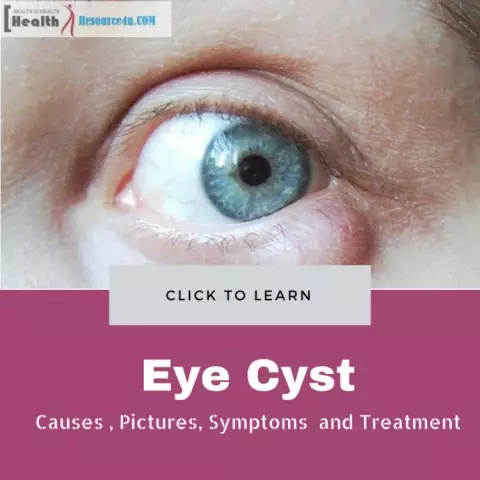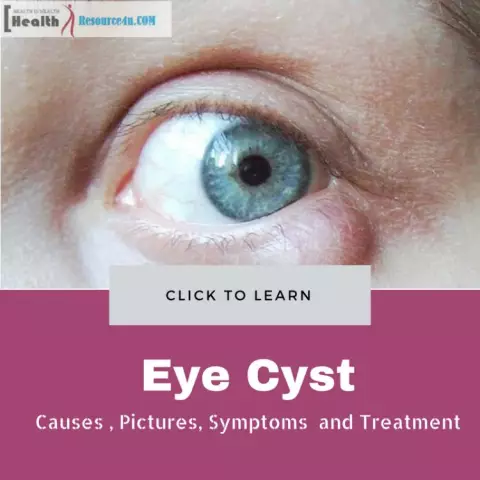- Author Rachel Wainwright [email protected].
- Public 2023-12-15 07:39.
- Last modified 2025-11-02 20:14.
Jaw cyst
The content of the article:
- Classification
- Description
-
Symptoms
Epidermal cyst
-
Treatment
Surgical removal
- Video
The jaw cyst is one of the variants of benign bone neoplasms and is a cavity filled with serous fluid.

In clinical practice, cysts of the lower jaw are more common
Classification
Cystic formations of this localization are classified in connection with the origin:
- Odontogenic - have a direct connection with the tooth or a violation of the correct laying of the tooth-forming epithelium. These cysts include radicular (apical, lateral, subperiosteal, residual), follicular, paradental and epidermoid.
- Neodontogenic, or true cysts of the jaw - not associated with tooth tissues. They are subdivided into nasopalatine (incisal canal), globulomaxillary (spherical-maxillary) and nasoalveolar (nasolabial).
Description
Neodontogenic cystic neoplasms have some common characteristics:
- The pathogenesis is based on a violation of facial embryogenesis (embryonic dysplasia). It is formed on the border of the embryonic facial processes, that is, the main cause of the disease is congenital.
- They have a cavity, which is delimited by a wall of fibrous tissue from the surrounding space (clearly seen in the photo).
- The cavity is filled with aseptic fluid. It is prone to suppuration, in this case it is filled with purulent contents and increases significantly (a tendency to melt tissue). With trauma, the fluid can become hemorrhagic due to bleeding into the cavity.
- The pathology is isolated and has no communication with the surrounding structures (localization exactly in the bone of the lower or upper jaw). Exceptions are neglected cases in which inflammation switches (contact path) to adjacent organs (teeth, sinuses).
In each individual case, cystic formations can have significant differences, which somewhat complicates the diagnosis.
Diagnosis is based on X-ray images (ultrasound is of no value, CT / MRI only in the course of differential diagnosis in incomprehensible cases).
The main treatment option is surgery to remove the cyst from the jaw tissue (cystotomy, cystectomy).
Symptoms
Symptoms of cysts in the jaw will depend on the specific type and degree of involvement of nearby tissues.
| View | Features: | Clinic |
| Nasopalatine (incisal canal) |
They develop from the embryonic remnants of the epithelium of the nasopalatine canal (connects the nasal and oral cavity). Most often occur in the lower sections of the canal. Localized between the central incisors. |
Slow growth explains the long absence of clinical manifestations. 1. Virtually painless (slight pulling or aching sensations in the upper or lower jaw). 2. When the palatine bone is destroyed (the anterior part of the palate behind the incisors), a hemispherical protrusion appears in the oral cavity. 3. When puncture of education receive a serous transparent liquid. 4. Difficulty in nasal breathing (the lower nasal passage is often involved). 5. Violation of sensitivity (numbness, twitching) when the nerve bundles are compressed. With suppuration, typical signs of abscesses appear: Sharp throbbing pain; Severe symptoms of intoxication (fever, intense headaches, nausea / vomiting); Local changes (edema, hyperemia, local temperature change, a symptom of fluctuations or purulent discharge from the cyst when it breaks out); · The occurrence of fistulas (communication of the oral and nasal cavity, which can lead to sinusitis and sinusitis). Suppuration is relatively infrequent. |
| Globulomaxillary (intramaxillary, spherical - maxillary) |
Localized between the lateral incisor and the canine on the upper jaw. They arise with improper fusion of the frontal and maxillary embryonic layers. |
Slow growth explains the long absence of symptoms. 1. Painless protrusion on the eve of the mouth and palate. 2. Difficulty breathing when invading the nasal cavity. 3. Development of the phenomena of sinusitis during germination in the maxillary sinus. 4. During puncture, a clear liquid with cholesterol inclusions is obtained. 5. Suppuration is extremely rare. Since the cysts are located between the roots of the teeth, odontogenic cysts (paradental cyst) can often form. |
| Nosoalveolar (nasolabial cysts of the vestibule of the nose) |
Localized on the anterior wall of the maxillary bone on the eve of the oral cavity, in the projection of the roots of the lateral incisor and canine. They arise when the fusion of the frontal, external nasal and maxillary embryonic sheets is disturbed. |
Clinical manifestations: 1. In the area of the nasolabial groove there is a protrusion of a round shape. On palpation, painless, mobile. 2. Difficulty breathing due to narrowing of the nasal passages. 3. Deformation of the facial skeleton occurs in connection with the localization of the cyst in soft tissues, and not just the intraosseous location. 4. Headaches due to irritation of the nerve endings. 5. Suppuration occurs relatively rarely. Puncture produces a transparent, somewhat viscous liquid. |
Epidermal cyst
As an example, consider a cystic formation, which is odontogenic in origin, but clinically more reminiscent of non-odontogenic formations - an epidermal cyst.
Features and clinical manifestations:
- It occurs in the area of the lower jaw.
- They have an asymptomatic course, since they grow extremely slowly, and are often an accidental finding in the images.
- In the cavity of the cyst there are both intact teeth and those that were involved in the pathological process (mixed genesis of the disease).
- The cavity is filled not with liquid, but with mushy contents (a dangerous differential symptom, which is also characteristic of some malignant tumors).
In this case, the cyst is conventionally a precancerous condition.
Treatment
Treatment of jaw cysts is mainly reduced to surgery, and although there are conservative methods, they are less effective and have a high risk of recurrence.
Surgical removal
The following types of operations are carried out:
- Cystectomy. Refers to radical methods, which is associated with excision of a hollow formation with all its membranes and suturing the edges of the wound.
- Cystotomy. It is only a partial excision of the cystic cavity and surrounding bone tissue (removal of the anterior wall). In this case, all the contents leave the cavity, and the resulting void serves as an additional bay in the oral cavity. The wound is not sutured, but tamponized (the dentist rinses the mouth 2 times a week and changes the turunda until complete healing).
- Plastic cystectomy. A variant in which the two above methods are combined. The cystic formation is removed completely, but the wound is not sutured, but tamponed with a muco-periosteal flap, which is held in the wound with an iodoform tampon.

Treatment of a jaw cyst consists in its surgical removal
The features of the methods are presented in the table.
| View | Indications | Advantages and disadvantages |
| Cystectomy | Used for all types of neoplasms (odontogenic and non-odontogenic) |
Positive sides: · Radical removal (reliability of the method); · Low risk of infection (the wound is sutured tightly). Negative sides: · A large amount of intervention and, as a result, high injury rate; Involvement of healthy teeth in the intraoperative or postoperative period); · Possible damage to the neurovascular bundle; · The possibility of injury to the sinuses. |
| Cystotomy. |
1. For large cystic lesions. 2. When growing into the sinus cavity. 3. When the bone plate is destroyed (with the risk of pathological fractures). 4. In the elderly with multiple concomitant diseases. 5. In persons with a violation of the blood coagulation system (hemophilia). 6. In children for the preservation of tooth germs. |
Positive sides: · Low invasiveness; · Fast and simple execution technique; · Low risk of damage to nerves, blood vessels and teeth. Negative sides: Incomplete excision (risk of recurrence); · The appearance of additional cavities; · High risk of secondary infection with open wound management. |
| Plastic cystectomy. |
1. Defect of the mucoperiosteal flap. 2. Divergence of the wound edges due to suppuration. |
It is used extremely rarely. It is performed in two stages: first, a classical cystotomy, and after 1-2 years, a classical cystectomy is performed. |
With suppurative processes in the cystic formations of the jaw, treatment is carried out using the same techniques, but only after the inflammatory process subsides. This means that in the first place is the drainage and cleaning of the cavity (excision of the cystic cavity is the second stage).
With the involvement of the sinuses, fistulas are formed to create a single natural system for the drainage of cystic formation (gradually epithelializes on its own and the fistula closes).
Video
We offer for viewing a video on the topic of the article.

Anna Kozlova Medical journalist About the author
Education: Rostov State Medical University, specialty "General Medicine".
The information is generalized and provided for informational purposes only. At the first sign of illness, see your doctor. Self-medication is hazardous to health!






